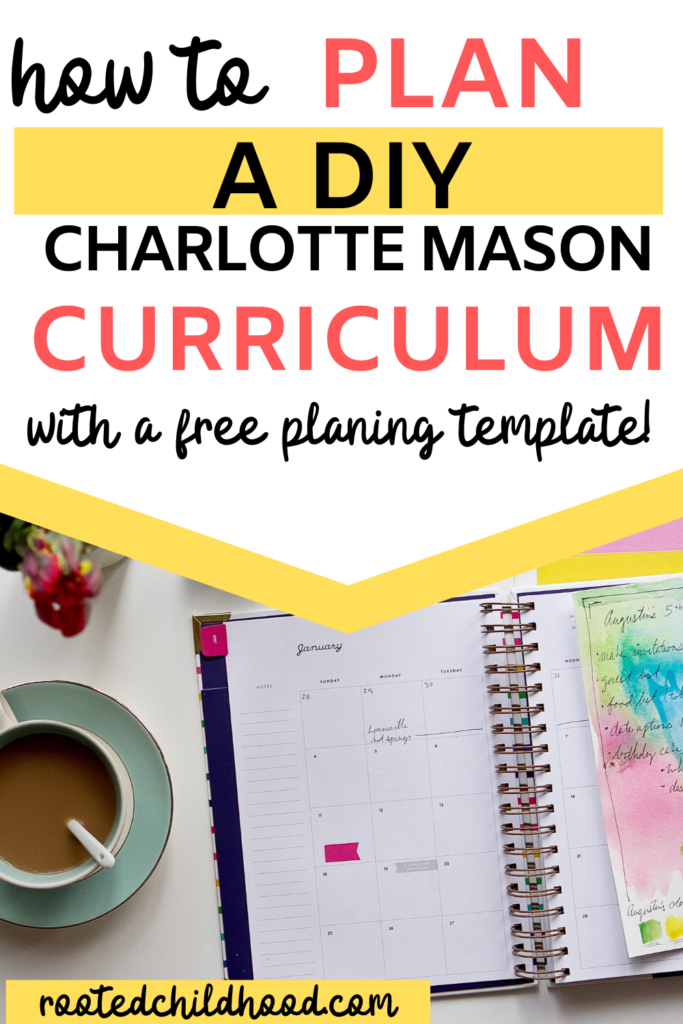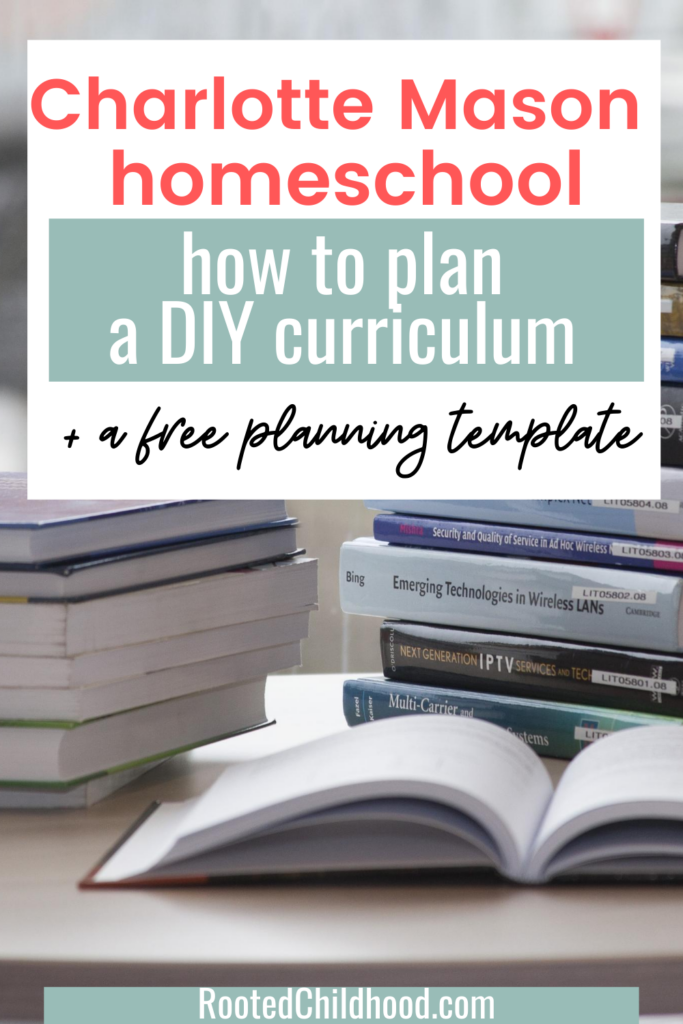It is hard to believe we’re almost ready to start our next school year!
Time really does fly when you’re having fun. It’s been four years since we officially started our homeschool journey when my daughter started kindergarten. We learned A LOT that year and every year since- not just about math and history and science, but about how my daughter learns best and how our family operates best.
Homeschooling is about so much more than what curriculum you use. For us, homeschooling is about creating an atmosphere of learning where questions, curiosity, and discovery are part of our family culture.

A Charlotte Mason Education
Our family is inspired by Charlotte Mason’s method of educating children. Charlotte Mason believed that a child is a whole person from birth and we must educate the whole person, not just their mind.
So what does that mean? A Charlotte Mason education is a wide, broad feast of ideas learned chiefly through living books. Living books aren’t textbooks; they’re books written by an author passionate about the subject that bring it to life through a story.
It is in the reading of living books and through the art of narration where the child tells back what he has heard or read that learning happens. In a Charlotte Mason education, there are no worksheets, no spelling tests, no pop quizzes, no busy work.
There are lots of wonderful books, detailed maps and reference materials, great conversations, and an atmosphere of joy and delight that leads to a true love of learning.
Planning a Charlotte Mason Education
The beauty of homeschooling is that we don’t have to use a one-size fits all curriculum. Honestly, one size wouldn’t even fit my three children!
I can already see that each of them learns differently and has different strengths and challenges. It is truly a blessing to be able to customize their educations to fit exactly where they are in life and to be able to choose the materials that will help lift them up to where I know they can succeed.
Before embarking on planning a Charlotte Mason education, reading Charlotte Mason’s own words should be required reading. If you have a child under 9, begin with Volume 1: Home Education in her homeschooling series. If you have a child older than 9, I recommend beginning with Volume 6: Towards a Philosophy of Education.
Once you have a foundation in the method, there are some great tools and resources to help with planning out your customized curriculum.
Tools to Help Plan Your Own Charlotte Mason Curriculum
This is the second year I have used the curriculum form guides from Charlotte Mason Plenary, and they are a simple and straightforward way to work through your plans. The guide goes through each subject with a short overview of what you should be covering as well as some options for resources.
There are many resources that Charlotte Mason used year after year with her students and some of those continue to be used today. Some resources have become outdated or need to be adjusted based on where we call home, but it is interesting to look back at the resources she used to get the scope of what was covered.
When I want to look at options for different subjects, I have loved following the recommendations over at Wildwood Curriculum. The free, secular Charlotte Mason resource is so well put together and there are so many options for each subject and grade level to find something that suits us.
Another amazing resource for determining what to cover in each year is the A Delectable Education podcast. There are episodes about every subject and so much information about how to implement the Charlotte Mason method.
For the past two years, I have done a one-on-one consultation with Liz and we have thoroughly enjoyed all of the book recommendations they provide. This year, I opted not to do a consultation because we’re going to study Texas history and I already knew what books I wanted to use for that and I feel like I have a better grasp on the type of books we do well with now.
You can see more about how I schedule all of our subjects and books with the scheduling cards from A Delectable Education here.
Planning from the top down
I have learned not to look too far ahead in homeschooling or even parenting. As my children continue grow and a learn and grow alongside them, it’s hard to imagine what our homeschool will look like in 3, 5, or 10 years.
Even though I don’t want to get ahead of myself, it is a good idea to have a big picture, high-level view of what you will cover over the years. I’m not fancy about this, but I did jot down a rough sketch of what we’ll cover through our homeschool when it comes to history.
There are lots of ideas about how to approach history cycles and streams even among Charlotte Mason “experts.” Choose what works for you, but do look ahead to make sure you are covering what you want.
Once you’ve looked at the big picture, think about the year and have a rough plan for what you’ll cover in the year and then drill down to what you’ll cover in a semester or term. Take each term it break it down into what you’ll cover for the week and then finally, go through each week to plan your daily schedule.
Putting It All Together
When I’m ready to sit down and plan out our year, I start by listing out our subjects on a spreadsheet. Scroll down to the end of this post to get the super basic spreadsheet I use!
Then I go through the list of subjects and determine what resources I’ll use for each subject for that year.
Next, I look at the calendar and determine our terms or semesters. For our first two years, we did three terms as Charlotte Mason did. I have found that this breakdown just doesn’t work for my brain so I break our year into two semesters to follow the traditional school calendar.
This means that our fall semester is a bit shorter than the spring semester. Most Charlotte Mason guides are broken down by three terms, but I take those and fit it into two by doing a 40/60 split of term 2 between the fall and spring semesters. Somehow it all works out!
I calculate out the number of weeks in each semester and list those weeks out on my spreadsheet.
Then I start filling in what resources we’ll use each week. I cross-reference the CM Plenary form guides to determine how many times each week each subject will be scheduled. If history is scheduled just once a week, I make sure to choose just one book in each slot for history. If literature is scheduled twice a week with instructions to use two different books, I will list both resources under each week.
As I am filling in the weeks, I like to have a physical copy of the books available because I need to go through and approximate how much we’ll be able to cover in one lesson. Some books are easily broken down into chapters that can be completed in one lesson but others may need two or three lessons to cover one chapter.
Under each week, I will write in the specific topics being covered and the page numbers of the books we need to read.
I never put dates on this planning schedule because in my experience, life happens 365 days a year. Things pop up and we may need to take a week off for something unexpected or we may get burnt out earlier than I anticipated. We start our school year a little early and plan to end a little early to allow room to adjust when needed. I don’t ever worry about “making up” days or missed work, we just continue on to the next thing on the schedule. That means we might do week 6 and then take a week off before we do week 7, but that’s OK- that’s the beauty of homeschooling!
Don’t Overthink It
In the beginning of my homeschooling journey, I remember being amazed at how coordinated some people could be. I’d see someone studying ancient Egypt and the pyramids right around Halloween at the exact moment a museum with an exhibit on hieroglyphics opened up and marvel at how awesome it must be to have themed learning like that.
I’ve since learned that unit studies are often more interesting to the teacher than the student, and even if your student does enjoy them, they are completely unnecessary. I can spend time over-planning our curriculum so that everything lines up perfectly for these “surprise” connections to be made, but I’ve learned that I don’t have to.
When children are learning from living books and internalizing what they learn through narration, they will be able to make connection weeks, months, or even years down the line. And then, when they make the connection, it is actually meaningful to them because *they* made the discovery and not you as the expert planner.
Just as an example, during my daughter’s first grade year we read Paddle-to-the-Sea, a book tracing a journey through the Great Lakes. I don’t know anything about the Great Lakes and couldn’t have planned a unit study on them if I tried! We just enjoyed the book, traced the journey through the lakes, and said farewell at the end of the book.
More than a year later, we read a biography of Pere Marquette, a missionary who traveled in Michigan and the Great Lakes area. My daughter instantly recognized the names of cities and different locations in the book because of Paddle-to-the-Sea’s journey.
Then more than a year after that, in our geography book, we read a chapter on the Great Lakes and my daughter was telling me about all the places Paddle-to-the-Sea and Pere Marquette went.
Sure, we could have crammed all of this knowledge about the Great Lakes into a one or two week study where I was the one getting the excitement from planning out all of those amazing connections, but instead, we let it unfold naturally and beautifully over the course of not weeks, but many years where my daughter got to experience the excitement of making those connections for herself.
All that to say…I don’t stress about studying turkeys around Thanksgiving or making sure that the composer we study is from the same country we’re studying in geography or that we learn about George Washington just before President’s Day. I put my trust in the method that real learning is taking place and that is more important than themed lessons or unit studies.
Focus on What’s Important
Above all, when planning our Charlotte Mason education, I put my relationship with my children first. An atmosphere of learning doesn’t involve tears or bad attitudes or not giving your best effort.
I will never be a slave to the curriculum. If something isn’t working, I re-evaluate it. Often, we can make small adjustments to effect the big picture in a positive way. But sometimes, we find a resource that just doesn’t work for us, and I’ve given myself permission to change things up without guilt anytime.
This attitude means we don’t finish every single book, and we won’t cover every single thing I had planned. My children are going to be just fine.
It isn’t my job to teach them everything; it is my job to teach them how to learn anything. That’s what’s important and that can happen with whatever curriculum you choose.
Focus on what’s important and you can’t go wrong.



Leave a Reply